|
Location:
Isle of Gavrinis, Lochmariaquer, France. |
Grid Reference:
47� 34' 56″ N, 2� 53' 42″ W. |

 Gavr'inis:
(Passage Mound).
Gavr'inis:
(Passage Mound).
The passage mound
on the island of Gavr'inis (goat island) is one of
the most spectacular in France. The engravings inside have made the site
famous, and rank it as one of the best of its kind in all Europe if not the
world. The design of the engravings on the stones
has been compared with those found at the famous passage-mounds of the Boyne
valley in Ireland.Directly in front of the mound
are the partially sunken remains of the twin stone-circles of Er-Lannic,
reminding us that the site was originally accessible by foot.
(Click
here for map of the site)
|
Gavr'inis: ('Goat Island') |
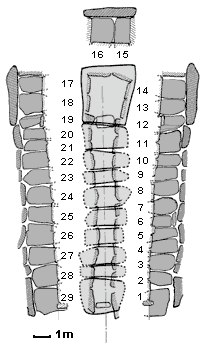
The Construction
-
The chambered mound on the
small island of Gavr'inis now lies about 500m off the Brittany coast,
and is today only accessible by boat. The island is actually a granite outcrop,
into which the upright stones of the passage mound were bedded in trenches
cut in the rock. Although similar in principle to several other
passage-mounds from the Armorican region (Man�-Lud
in Locmariaquer, L'�le-longue nearby, and Barnenez in Finist�re),
Gavrinis has several features which otherwise make it
exceptional to French prehistoric architecture, while at the same time,
having some strong similarities to both the Boyne-valley passage mounds,
and others in the British Isles (see
below for more).
Inside the mound, the significant degree of engravings on
almost all the stones makes it immediately apparent that the builders
were attempting to convey a special statement through this structure and
it may or may not be relevant that
'Neolithic pottery artefacts found in the chamber contain traces
of cannabis'. (3)

(Other
Examples of prehistoric Drug-use)
Both the exterior design and the interior carvings are unlike
that seen at any other French passage mound, and show a similarity to
engravings from both Ireland and Scotland. The floor-level of the camber
was raised (see above), and a pavement put in place before the mound was
constructed around it (the floor of the chamber is made of a single
block of stone), and the passage was built orientated so as to face the
mid-winter sunrise. Some of the stones appear to have been re-used and
even re-worked, most notably the capstone.
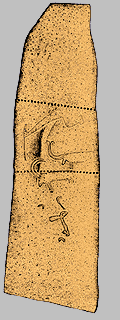
The capstone - The capstone for the
Gavrinis passage mound (centre section, diagram left), was found to have
engravings on the upper, hidden face, which matched the carvings found on
the capstone at nearby
La Table des Marchands
(bottom section, diagram left).
It is now known that these two stones and the capstone
from Er-Grah tumulus (upper section,
diagram left) are actually fragments of a larger stone, which was
itself once a part of a
construction dating from 4,000 BC, (probably including
Le Grande menhir Bris �). We
can assume from this that Gavrinis is contemporary with both La Table des
Marchands, and the Er-Grah tumulus, an idea which is supported by
radio-carbon dating. The large scale re-use of pre-existing
monuments is indicative of a shift in politics or religious thinking, and it
is perhaps no coincidence that this date (3,300 - 3,100 BC), is the same
ascribed to the monuments of the Boyne-Valley, in Ireland, along with
Stonehenge I, Avebury/Silbury, and several other significant monuments in
France and the British isles.
(More about
the re-use of the Lochmariarcer menhirs)
The walls consist of 12 pillars on the north-east side and 11 pillars on the south-west side
(two of which are quartz - i.e. No 11). From a total
number of 29 stones, 23 are engraved.
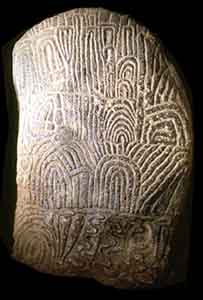
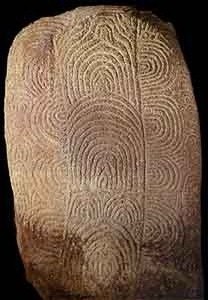
From left to right: Stones 8 and 9.
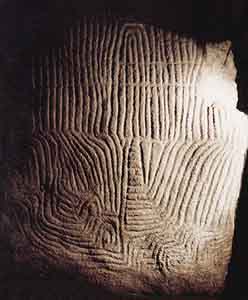
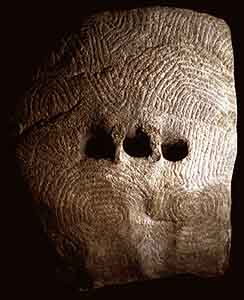
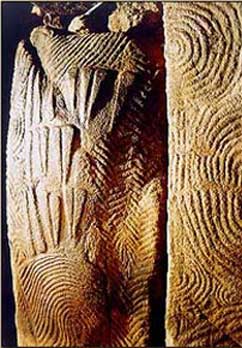
From left to right: Stones 16, 18 (from inside the chamber) and 21
The following photos are from Gavrinis and Newgrange (Ireland). These kerbstone
on the right has often been said to demonstrate a connection between the two sites. Combined with the
fact that they are both orientated in the same direction and that they
were built at the same time, there does indeed seem to be an argument in
favour of contact between the builders of the megaliths at Carnac (c. 3,300
- 3,100 BC) and those of the passage mounds in Ireland (at the same
period of time)
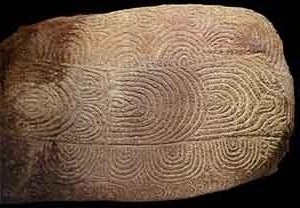
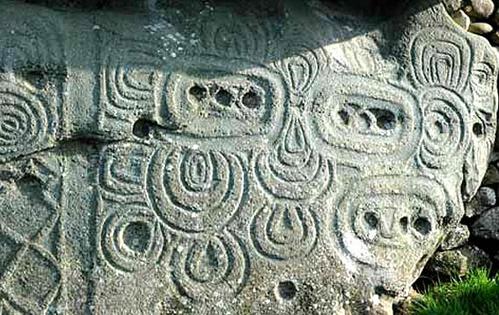
While there is a similarity in design - For example, between Gavr'inis
(stone 9) and the Kerbstone (K52) (right),
at the rear of Newgrange, the two styles also have noticeable differences.
Note: The three holes as at stone 18, above.
|
The Boyne Valley connection:
Apart from the fact that Gavrinis was
built at the same time as the Boyne-valley passage mounds, there are several
construction features such as the
distinct upward sloping passage (orientated to the mid-winter sunrise),
although at Newgrange the design narrows the beam of sunlight to a small
dagger-length strip of light.
There is a stone in the floor of the mound (a 'sill-stone'), which shows extreme similarities
to stones found at both
Newgrange and
Fourknocks in Ireland. It is
suggested
that the carvings on the stone have a symbolic meaning, although it can only
be guessed at now. Cope
(1)
suggests that they are symbolic of the portal to the
inner sanctum.
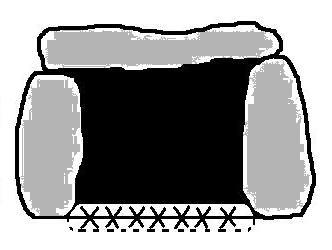
(More about 'Sill-stones' and 'light-boxes')
The similarity in the engravings and design
features suggests a connection, but at the same time highlights
differences between the two builders. The location of the
stone is similar to the 'sill-stones' found in Irish passage
mounds (such as at Carrowmore), where stones were placed upright
into the floor, raised slightly above floor level. The same design
feature is found in sea-going ships.
(Other
similarities to the
Boyne-valley passage mounds) |
Chronology -
The passage mound has been dated to around 3,550 - 2,950 BC (already
corrected for), from a piece of
charcoal from one of a wooden construction (Gif 5766), by the entrance.
(2)
The passage was later entirely filled with
loose rubble, which can only have been done deliberately.
Archaeo-astronomy
-
The orientation of the passage to the winter solstice is the most obvious
astronomical feature of the site, however, the close association between
Gavrinis and other sites with astronomical orientation, such as
Newgrange in
Ireland, and
La Table des Marchands
nearby confirm the importance of (Solar) astronomy to the builders
The only way light can be seen from the chamber is by bending down.
Gallery of images:
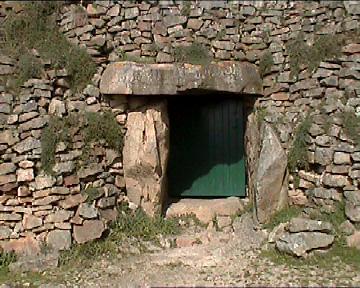 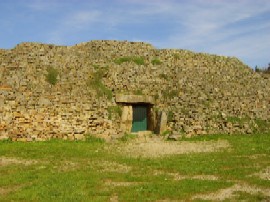
Opposite the entrance to the mound is the small island
of
Er-Lannic, which contains both standing stones and two stone-circles,
although one of these is now mostly underwater.
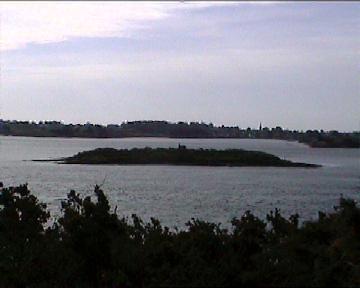
(Passage
Mounds Homepage)
(Other French Sites)
|














